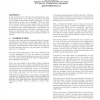Free Online Productivity Tools
i2Speak
i2Symbol
i2OCR
iTex2Img
iWeb2Print
iWeb2Shot
i2Type
iPdf2Split
iPdf2Merge
i2Bopomofo
i2Arabic
i2Style
i2Image
i2PDF
iLatex2Rtf
Sci2ools
COMPGEOM
2000
ACM
2000
ACM
Pitfalls in computing with pseudorandom determinants
It has been known for 30 years that pseudorandom number generators in the class of linear congruential generators (LCG) exhibit strong and predictable regularities. A widely used generator in this class is drand48. While the regularity is not problematic in most applications, I show that it can produce very misleading results in testing geometric algorithms that involve determinant computations. By presenting scenarios where LCG behave ‘nonrandom’ (sometimes in a spectacular way), I want to raise awareness for possible problems with LCG and pseudorandom numbers in general.
COMPGEOM 2000 | Discrete Geometry | Linear Congruential Generators | Pseudorandom Number Generators | Pseudorandom Numbers |
Related Content
| Added | 01 Aug 2010 |
| Updated | 01 Aug 2010 |
| Type | Conference |
| Year | 2000 |
| Where | COMPGEOM |
| Authors | Bernd Gärtner |
Comments (0)

